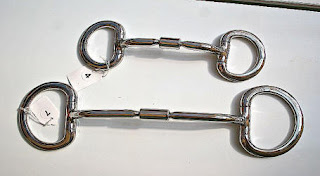What is a 'Reward'?
Rewards come in many forms. Most people think of 'Treats' when they reward their horse, but horses don't reward each other by giving edible items. In fact, using treats to reward, can and does lead to vices such as nipping, pocket searching and resentment, if a treat is not forthcoming - exactly the opposite of what you are trying to achieve.
Consider a lead mare in a group of horses. She will chase another horse at the least sign of insubordination, but when the culprit shows sufficient apology, she stops the chasing and removes the pressure. Lead horses reward another horse's 'Good' behaviour by taking the pressure off and cement relationships by mutual grooming, etc. We can replicate this during our riding by lessening or removing pressure when our horse does the right thing, together with a stroke on the neck or using the voice to say, “Good boy”. Unlike punishment, the reward explains to the horse exactly what he did that was right, provided that the release comes with split second accuracy at the precise moment that the 'right thing' occurs. This ensures that he stays content and cooperative throughout the levels.
A reward can be riding straight and forward after a lateral
exercise or letting the horse stretch on a long rein. The lessening of an aid, such as a strong hand or leg, can also be a reward. For example, if the horse
is alert and going forward, he will be rewarded when the rider lightens her leg
at the very moment he starts to go nicely. Then the horse will learn that when
he feels the pressure of the leg and goes forward, he gets the reward
immediately.
Punishment does not
teach a horse what to do. Most of the time it only causes confusion and resentment as most times the horse is simply communicating to you that he either does not understand the request, or that the request is uncomfortable or painful. Punishment is only valid if the above do not apply and the horse knows exactly what he did that was wrong and that he was being disrespectful for doing it. It does not
explain to him how to achieve what the rider is requiring or even what that requirement is. For example, you see a lot of
riders punishing their horses for not standing still at the halt. The rider will pull he reins, apply the leg, even smack the horse - all signals that mean 'move' to the horse! But they don't tell
the horse in a constructive way what to do, such as dropping all pressure - and the reins - the moment that the horse stands still. Horses only
understand through a reward.
Another way that you can reward your horse when first teaching a
movement is to only do a step or two and not maintain it. If I want to teach my
horse to move sideways from my right leg, for example, and he responds to my
leg by moving his haunches left and moving a step to the left, I reward him
right away by ceasing my leg aid, petting him and riding straight and forward.
Then you do the same thing again. Step-by-step rewarding will ensure that you
create a solid understanding of the aids on which you can build. If you insist
that your horse continue to do more steps at a time or try to maintain the
movement, he will get confused. It will not be clear to him what you want.
Once you get a solid, immediate response to your aid, you
can delay the reward and ask for a few more steps. After those additional good
steps, in which you have lessened the pressure of the leg, you may reward him
by going straight. If you insist without making sure the horse really
understands what you want, he will become cranky and unresponsive. Sometimes
you can see this at shows: The horse has spur marks in his sides, the rider is
pushing and pushing, and the horse is swishing his tail and is tense in his
back and unwilling to go forward. The horse and rider are not speaking the same
language.
Blind repetition acts like punishment and makes a horse
dull. It does not make the horse understand the exercise better. Also, muscles
get tired. If the horse does something well, I may do it once again but then I reward him by putting him away and let him absorb just what it was that he did right.
The principle of rewarding after a good response is just as
important when you ride at the highest level, where the demands on the horse
reach the limits of his physical ability. If the horse is trained by
punishment, drill or repetition, he'll soon learn to hate his job, and you'll
have a horse that's not willing and eager to work for you.


















